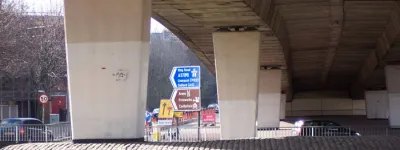Forest City's plans for the crossing involved painting two parallel lines across the road to mark the crossing place — "Pedestrian Safety Zone Lines" to be precise — and marking another line further back along with the word "STOP" to keep waiting traffic a cautious 20 feet from the crossing. If £65 was too steep, the 1920s traffic engineer could opt for a two-light system, with only red and green, or even a one-light system, with just a red 'stop' light that lit up when the button was pressed, the latter being a much more reasonable £45. It wasn't long before the design was modified to include signals for pedestrians too, though at first these were simply another set of red, amber and green lights facing the pavement. At the time, with no established convention, the amber light always appeared simultaneously with either the red or green light instead of on its own.
Some of the earliest of these crossings were installed on the A23 London to Brighton road that same year, in response to several serious accidents involving people trying to cross, including an alderman who was knocked over and the death of a former councillor. The Evening Standard announced the "Croydon Experiment" with much fanfare, announcing with some excitement:
"Croydon is to adopt the remarkable method of enabling pedestrians to control traffic by means of a push button... The Council have decided to erect a new type of automatic light signal for pedestrians and traffic combined. They claim that this will make it safe for residents to cross the main London-Brighton road.
"When a pedestrian pushes a button the red light on the signal post will flash to stop all traffic in both directions so that it comes to a standstill on a line 20ft. away.
"An official of the Borough Surveyor's Department said to me this afternoon: 'The new signals will be controlled by the police for the first fortnight until the public become accustomed to them.'"
Evening Standard article 27/10/31
104.11 KB
